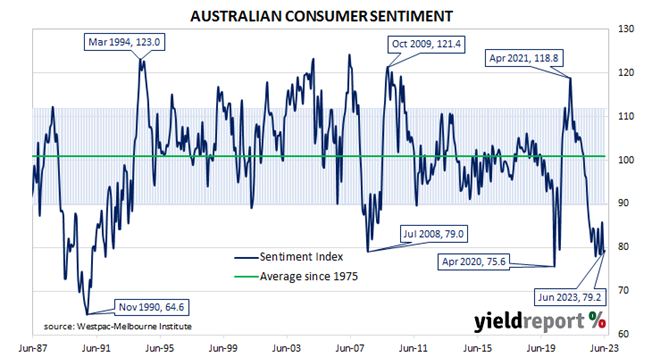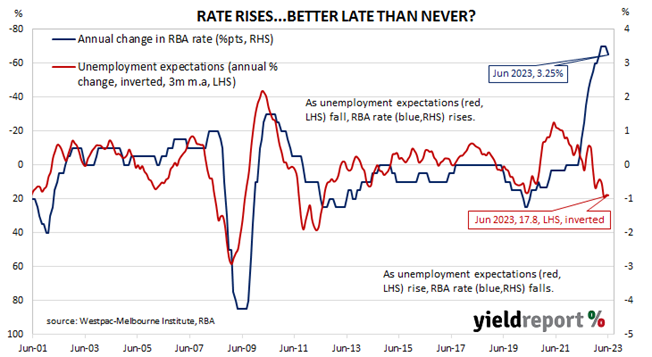Summary: Household sentiment improves slightly in June; big rate-rise impact; confidence had improved prior to rate decision, tumbled afterwards; inflation, economic conditions, Federal Budget, taxation also weigh; two of five sub-indices higher; more respondents expecting higher jobless rate.
After a lengthy divergence between measures of consumer sentiment and business confidence in Australia which began in 2014, confidence readings of the two sectors converged again in mid-July 2018. Both measures then deteriorated gradually in trend terms, with consumer confidence leading the way. Household sentiment fell off a cliff in April 2020 but, after a few months of to-ing and fro-ing, it then staged a full recovery. However, consumer sentiment has deteriorated significantly over the past two years, while business sentiment has been more robust.
According to the latest Westpac-Melbourne Institute survey conducted in the week before Easter, household sentiment has improved but only to a level which is still very depressed. Their Consumer Sentiment Index increased from May’s reading of 79.0 to 79.2, a reading which is well below the “normal” range and significantly lower than the long-term average reading of just over 101.
“While the full survey showed little net change in sentiment, responses within the survey week show a big rate-rise impact,” said Westpac Chief Economist Bill Evans.
Any reading of the Consumer Sentiment Index below 100 indicates the number of consumers who are pessimistic is greater than the number of consumers who are optimistic.
The report was released on the same day as the latest NAB business survey and Commonwealth Government bond yields declined on the day. By the close of business, the 3-year ACGB yield had lost 2bps to 3.83%, the 10-year yield had slipped 1bp to 3.94% while the 20-year yield finished 3bps lower at 4.23%.
In the cash futures market, expectations regarding further rate rises in 2023 softened slightly while expectations regarding rises in the first half of 2024 firmed a little. At the end of the day, contracts implied the cash rate would rise from the current rate of 4.07% to average 4.145% in July and then to 4.285% in August. February 2024 contracts implied a 4.425% average cash rate while May 2024 contracts implied 4.28%, 21bps more than the current rate.
“Prior to the announcement of the rate-hike decision confidence had lifted sharply from 79.0 in May to 89.0. But following the announcement it tumbled to an extremely low 72.6,” Evans added.
However, Evans also noted 62% of respondents of follow-up questions recalled news items regarding inflation while around 40% of respondents referred to economic conditions in general, the Federal Budget and taxation.
Only two of the five sub-indices registered higher readings, with the “Economic conditions – next 5 years” sub-index posting the largest monthly percentage gain.
The Unemployment Expectations index, formerly a useful guide to RBA rate changes, rose from 123.2 to 131.3. Higher readings result from more respondents expecting a higher unemployment rate in the year ahead.



